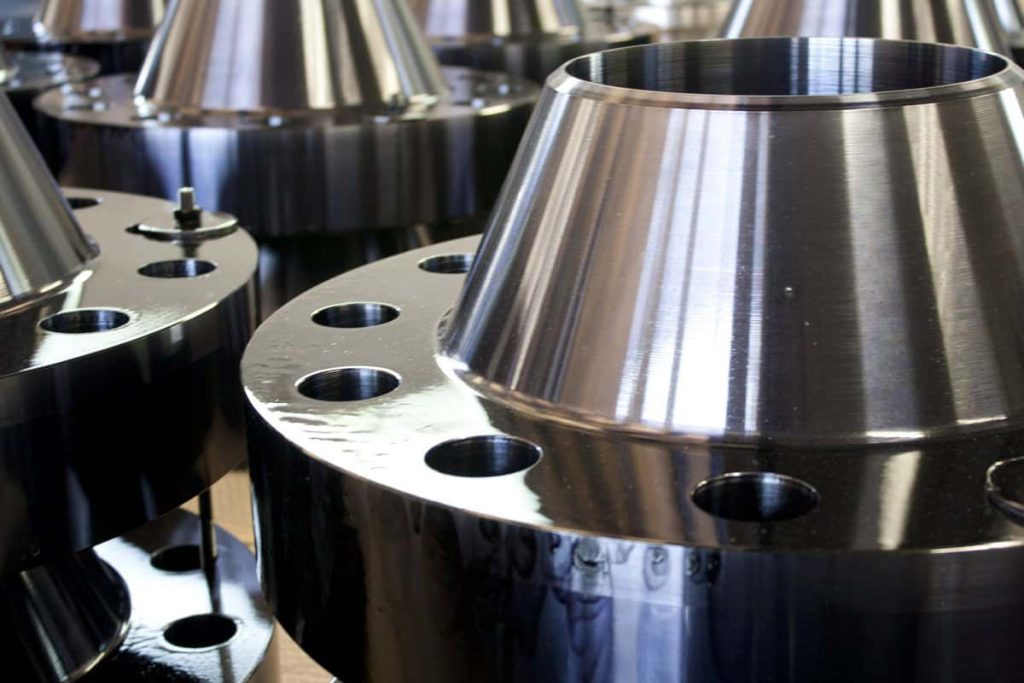HOT FORGED NICKEL ALLOY FLANGES
We specialize in the molding of nickel alloy flanges and duplex and superduplex steels. Non-standard flanges produced according to specific customer requirements, such as welding neck flanges, are our specialization.
Slip On Flanges
Slip-On Flanges continue to be preferred for welding neck flanges by many users due to their initially lower cost, the less precision required in cutting the pipe to length, and the greater ease of aligning the assembly; however, their final installation cost is probably not much, if anything, less than that of weld neck flanges. Their calculated strength under internal pressure is approximately two-thirds that of the weld neck flanges, and their fatigue life is approximately one-third that of the latter. For these reasons, mating flanges are limited to 1/2″ to 2 1/2″ sizes in the 1500 lb. standard and are not shown in the 2500 lb. standard.

ANSI classes 150-2500 Dimensional data
- Class 150 [63 kb]
- Class 300 [64 kb]
- Class 600 [64 kb]
- Class 900 [62 kb]
- Class 1500 [64 kb]
- Class 2500 [49 kb]
Welding neck flanges are distinguished from other types by their long conical hub and the delicate thickness transition in the butt weld area that joins them to the pipe. The long tapered hub provides important reinforcement of the flange precisely from the point of view of strength and resistance to disengagement. The smooth transition from flange thickness to pipe wall thickness effected by tapering is extremely advantageous under conditions of repeated bending, caused by line expansion or other variable forces, and produces a tensile strength of neck flanged assemblies equivalent to that of a butt welded joint between pipes, which, in practice, is the same as that of the non-welded pipe. Therefore, this type of flange is preferred for every severe service condition, regardless of whether it is due to high pressure or sub-zero or high temperatures,

ANSI classes 150-2500 Dimensional data
- Class 150 [63 kb]
- Class 300 [64 kb]
- Class 600 [64 kb]
- Class 900 [62 kb]
- Class 1500 [64 kb]
- Class 2500 [49 kb]
——————————–
Blind flanges
Blind flanges are used to blank the ends of pipelines, valves and pressure vessel opening. From an internal pressure and bolt loading perspective, blind flanges, particularly in the larger sizes, are the most stressed of all flange types; however, because the maximum stresses in a blind flange are bending stresses at the center, they can be safely allowed to be higher than other types of flanges

ANSI classes 150-2500 Dimensional data
- Class 150 [63 kb]
- Class 300 [64 kb]
- Class 600 [64 kb]
- Class 900 [62 kb]
- Class 1500 [64 kb]
- Class 2500 [49 kb]
——————————-
Threaded flanges
Threaded flanges are confined to special applications. Their main merit lies in the fact that they can be assembled without welding, which explains their use in very high pressure services, particularly at or near atmospheric temperature, where alloy steel is essential for strength and where post-weld heat treatment it is impracticable. Threaded flanges are unsuitable for conditions involving temperature or bending stresses of any magnitude, particularly under cyclic conditions, where leakage through the threads can occur in relatively few heating or stress cycles; sea welding is sometimes employed to overcome this, but cannot be considered entirely satisfactory.

ANSI classes 150-2500 Dimensional data
- Class 150 [63 kb]
- Class 300 [64 kb]
- Class 600 [64 kb]
- Class 900 [62 kb]
- Class 1500 [64 kb]
- Class 2500 [49 kb]
———————————
Socket welding flanges
Pipe welding flanges were initially developed for use on small high pressure pipelines. When supplied with an internal weld, their static strength is equal to, but their fatigue strength is 50% higher than double-weld weld flanges. Smooth bore conditions (internal weld grinding) can be easily achieved without having to bevel the flange surface and, after welding, to re-face the flange as would be necessary with sliding flanges. The internally welded socket type flange is popular for chemical process piping for this reason.

ANSI classes 150-2500 Dimensional data
- Class 150 [63 kb]
- Class 300 [64 kb]
- Class 600 [64 kb]
- Class 900 [62 kb]
- Class 1500 [64 kb]
- Class 2500 [49 kb]




